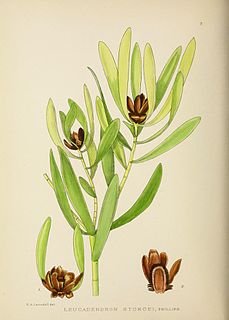
Dioscoreaceae is a family of monocotyledonous flowering plants, with about 715 known species in nine genera. The best-known member of the family is the yam.

Botrychium is a genus of ferns, seedless vascular plants in the family Ophioglossaceae. Botrychium species are known as moonworts. They are small, with fleshy roots, and reproduce by spores shed into the air. One part of the leaf, the trophophore, is sterile and fernlike; the other, the sporophore, is fertile and carries the clusters of sporangia or spore cases. Some species only occasionally emerge above ground and gain most of their nourishment from an association with mycorrhizal fungi.

Lolium is a genus of tufted grasses in the bluegrass subfamily of the grass family. It is often called ryegrass, but this term is sometimes used to refer to grasses in other genera.

Falconeria is a monotypic plant genus in the family Euphorbiaceae, first described as a genus in 1839. The genus is sometimes included within the genus Sapium. The sole species is Falconeria insignis. The plant is found from India, Nepal, Bangladesh, and Sri Lanka to Indochina, China, Thailand and Peninsular Malaysia.
Picrodendron is a genus of plant belonging to the family Picrodendraceae described as a genus in 1859.

Iva is a genus of wind-pollinated plants in the daisy family, described as a genus by Linnaeus in 1753. Plants of this genus are known generally as marsh elders. The genus is native to North America.
Colpodium is a genus of plants in the grass family, native primarily to Asia but with a few species on certain mountains in Africa.

Paul Carpenter Standley was an American botanist.
Austrofestuca, called beach fescue, is a genus of Australian and New Zealand plants in the grass family. The only accepted species is Austrofestuca littoralis, native to seacoast regions in Australia and New Zealand.
Lepidophyllum is a genus of South American flowering plants in the daisy family.
Metabuprestium is a fossil genus of beetles in the family Buprestidae, containing the following species:
The World Checklist of Selected Plant Families is an "international collaborative programme that provides the latest peer reviewed and published opinions on the accepted scientific names and synonyms of selected plant families." Maintained by the Royal Botanic Gardens, Kew, it is available online, allowing searches for the names of families, genera and species, as well as the ability to create checklists.
Festuca frederikseniae is a species of grass native to Greenland, Newfoundland, Labrador, and to a few islands in eastern Québec. In Iceland and southern Greenland, a few populations have been found that may be hybrids between F. rubra and either F. frederikseniae or F. vivipara. The purported hybrids have been named F. x villosa-vivipara. All these species grow on cliffs and on rocky or sandy soils in alpine tundra.

Leucadendron microcephalum, common name oilbract conebrush, is a dioecious, single-stemmed, South African shrub belonging to the family Proteaceae, endemic to the Western Cape and growing from sea level to 1,200 m (3,900 ft). It is one of some 200 species in the genus, all confined to South Africa.
Hookerochloa is a genus of Australian plants in the grass family.
- Hookerochloa eriopoda(Vickery) S.W.L.Jacobs - Queensland, New South Wales, Victoria
- Hookerochloa hookeriana(F.Muell. ex Hook.f.) E.B.Alexeev - New South Wales, Victoria, Tasmania
Hyalopoa is a genus of Asian plants in the grass family.

Avenula is a genus of Eurasian flowering plants in the grass family. Over 100 names have been proposed for species, subspecies, varieties, and other infraspecific taxa within Avenula, but only one species is accepted. The others names are all regarded as synonyms of other accepted names. The only recognized species in the genus is Avenula pubescens, commonly known as downy oat-grass or downy alpine oatgrass, native to Europe and Asia from Iceland and Portugal to Xinjiang, Mongolia, and Siberia. It is also naturalized in scattered locations in North America, in states as Connecticut, Delaware, Minnesota, New Jersey and Vermont, and in Canadian provinces such as Alberta, Manitoba, Ontario, Quebec, and Saskatchewan.
Evgenii Borisovich Alexeev was a Soviet botanist.
Plants of the World Online is an online database published by the Royal Botanic Gardens, Kew. It was launched in March 2017 with the ultimate aim being "to enable users to access information on all the world's known seed-bearing plants by 2020". The initial focus was on tropical African Floras, particularly Flora Zambesiaca, Flora of West Tropical Africa and Flora of Tropical East Africa.
Beauprea spathulaefolia is a species of flowering plants in the family Proteaceae. It is found in New Caledonia.







